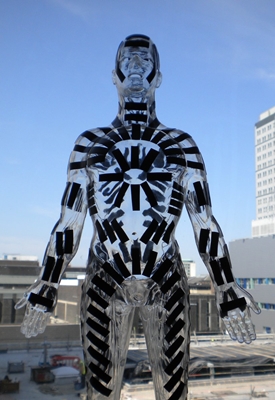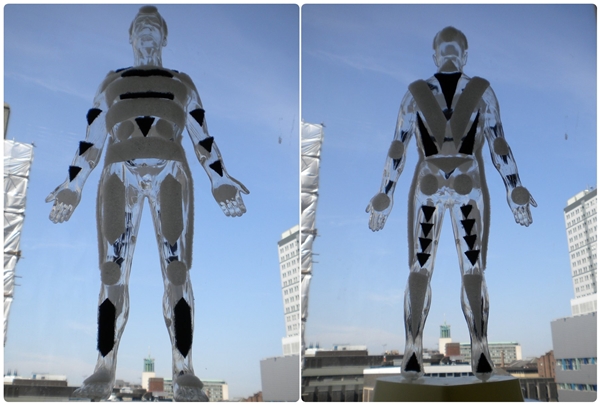Report
by Helen Schell
- Published: Tuesday, September 17 2013 15:34
Visual artist working in the field of space exploration and the cosmos. This article was written for an artist’s book ‘Oltramarino’ (a collection of thoughts on what it is to be human), by Louise Mackenzie. Much thanks to all the scientists whose research I have gathered up to write this and it is primarily used to introduce space exploration to varied groups of people, who have yet to understand that they are part of a dynamic new space-age.

Introduction
Atoms exist for a billion trillion years – we are made from stardust. Carbon is the beginning of life and is created inside aging stars. The atoms that make up our bodies are a temporary arrangement, and through the years they will become many different states, maybe a plant, maybe an insect or another human being, and then back to the stars. We are made from the ingredients of a Cosmic Recipe. There are 92 naturally occurring elements in the universe. Hydrogen was the first to be created and is the most prevalent.
Life in the Universe
The development of life on Earth was an inevitable consequence of the physical laws that govern the universe….we are all made of one thing, the same energy process, which simply changes from one form to another in a continuous cycle. Therefore, there has to be other life throughout the universe. There was only energy to start with and this transformed to create matter as well. The energy in the universe is changing from high quality ordered energy to low quality disordered energy. An example of this process is; our Sun radiates high quality energy, passes through humans (life), and we radiate low quality energy back in to the universe.
Life in the Galaxy
The Milky Way is vast, about 100,000 light years in diameter and contains 200-400 billion stars… so there will be many planets. Travelling at hypervelocity, it would take 20 million years to journey across the galaxy, and it is one of about 200 billion galaxies. In 2013, there were 940 recorded planets, and this means there’s a possible 17 billion Earth sized planets in the Milky Way. The Kepler Space telescope has been attempting to measure their atmospheres by using a spectrometer to see if there is a possibility of the existence of life. Earth’s gravity defines the limits of life on this planet. Other discovered exoplanets are much bigger, therefore far more gravity, and life forms would look different, imagine what 6 times the amount of gravity might do. We have yet to discover life beyond our planet, but it becomes increasingly likely that this will happen.

Life on Mars
There is now mounting evidence that life could have existed on Mars, images of Mercury showing signs of organic materials, and possibly microbial life within the gas clouds of Venus. Europa, one of the moons of Jupiter has oceans under its icy crust. Water exists over our Solar System and is moved around by comets and asteroids. Water is the basis for everything we currently understand as life. In our Solar System, Mars has the closest environmental conditions to Earth and when it was forming it was much hotter than it is now, so more conducive to the recipe of life. The Curiosity Mars Rover mission has recently confirmed that Mars has the right conditions to nurture life, but as yet hasn’t found evidence of it. Curiosity is looking for carbonates, which are the precious life enhancing elements. Due to the high cosmic radiation, they are unlikely to exist on the surface. The ExoMars Rover will be sent up by ESA in 2018, and will have a better capability to find it, being able to drill deep below the surface. Earth is protected by its atmosphere from cosmic radiation, but there is microbial life which thrives in very extreme conditions, similar to Mars, in the Rio Tinto River, where they feed on iron and sulphur, producing sulphuric acid as waste.
Life on Earth
Around 4 billion years ago, the origin of life was formed on Earth, which was within 300 million years of its creation within the Solar System. We have found fossils of cyanobacteria that are 3.4 billion years old.
All living things are connected through the same genetic code, which goes back to the first emergence of life on this planet. We could speculate that all living things are connected throughout the universe and life is Panspermic. Are we from a universal life pattern given that proto Earth was transformed radically by a Mars sized comet which crashed into it and deposited a huge amount of water on the surface. This event also threw off the debris which formed our Moon. The existence of the Moon helped to create life by slowing down the spin of the Earth to its current 24 hour day. Also it tilted the Earth’s axis to between 22-24 degrees, causing seasons and life to thrive. The action of the tides may have had several affects, one causing movement and the other causing bacteria from the oceans to be washed up on the shore and then reacting to sunlight causing a process of evolution. The process of heat (electricity), light and movement forms life. The building blocks of life were trapped in chambers in seawater creating proton gradients. Proton gradients are the universal spark of life. We still get our energy from this, wrapped up in bacteria called mitochondria.
The first half of planet Earth’s existence it had no oxygen; it had a sulphur dioxide atmosphere. Where did oxygen come from? It came from cyanobacteria. Fossils have been discovered that prove it existed 3.5 billion years ago, but it took another billion years before it split pigment apart to make oxygen. It created green - chlorophyll. The process of oxygenic photosynthesis evolved once it changed the world to green. This green released oxygen into the atmosphere and created complex life….us. Only one cyanobacteria gene still exists and all life shares this.

Carbon is the beginning of life and is created inside aging stars. On Earth this became the compound carbon dioxide. The carbon cycle is the circle of life. Cells of all living things are salty water, also being a conductor of electricity.
Bacteria are the dominant form of life on this planet and were the first life on Earth. They flourish in zero gravity conditions as well. There are more bacteria on our planet than stars in the universe. For 10 years in Chile, at European Southern Observatory, they have been filming one area of the galaxy and recording the movement of stars around a black hole through a radio telescope. In an uncanny way this reflects a similar pattern of movement to that of cyanobacteria seen through a microscope. Is this because both are affected by the same force of gravity, and the electro-magnetic energy of the universe? If the same universal laws act on everything, then it makes sense that it looks similar whether it is macro or micro.
Heavenly Bodies – The Human Spaceship
The above information has been compiled as part of this new art project, where I am examining ideas about humans venturing and living off planet Earth. Can we actually do this?
Over the next 10 years, space scientists and engineers are in the process of constructing, and planning to deploy several huge telescopes, both on Earth and in space. These will be used to view across the universe to the beginning of what we call time. With this extraordinary feat, these devices will also have the ability to look at the smallest particle that makes up the universe.
The Human Spaceship project explores ideas about how the human body could survive in space in the context of colonisation. The project questions our ability to survive and thrive in the hostile environment of space. The aim is to work with experts, experimenting with ideas to create humorous apparel and apparatus, enabling us to investigate the effects of zero/micro gravity conditions, radiation, isolation, and biomedical circumstances. Can we live off planet Earth and develop colonies either on human-made or natural satellites? Is it realistic to think we can exist there for long periods and procreate in these regions? If we can live in these different environments, will we eventually evolve into different creatures? Is our compulsion for space exploration programmed into us being that we are made from stardust? This project has the potential to be developed in diverse ways, and we are part of a new 21st century space-age, it causes great curiosity and debate, affecting our everyday life through our current digital technology.
Even though space is a very hostile environment for the human body, which is exactly attuned to the precise conditions on Earth, we seem driven to explore this realm. As we are made from stars are we hard wired to return to them?
###
Helen Schell can be contacted through NewBridge Project, Newcastle.








Comments